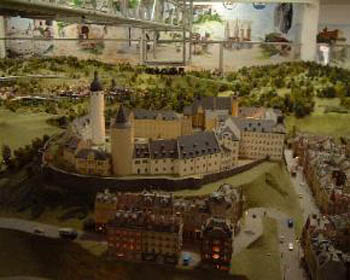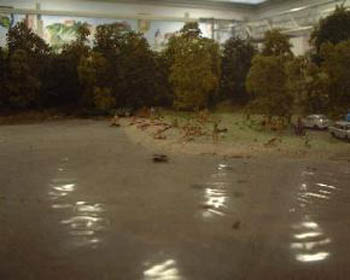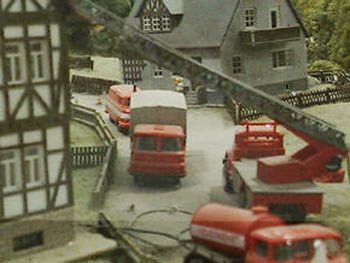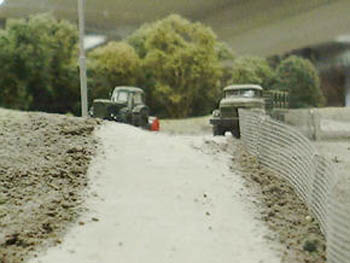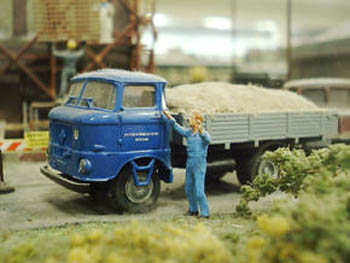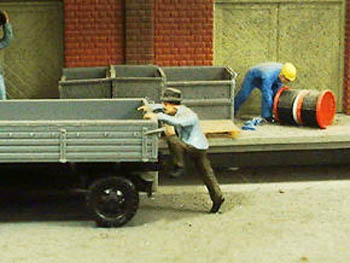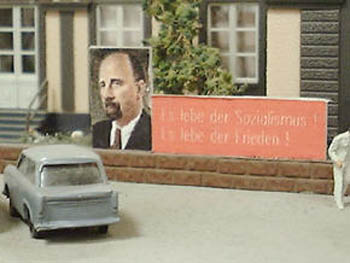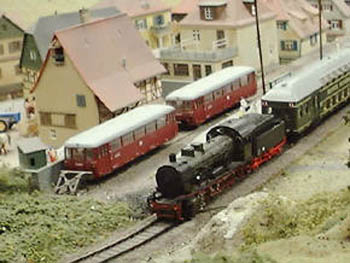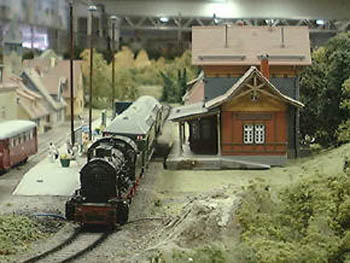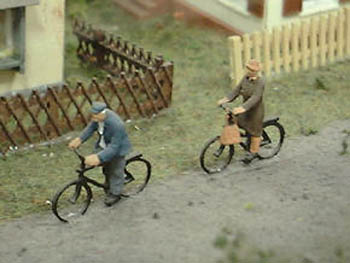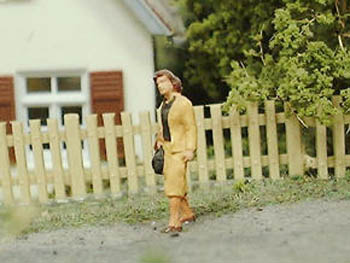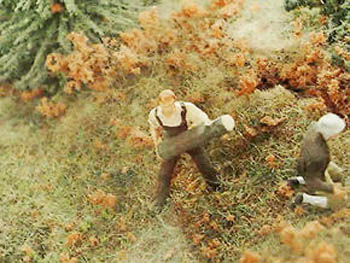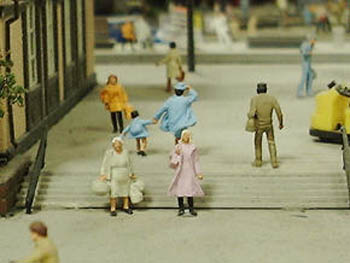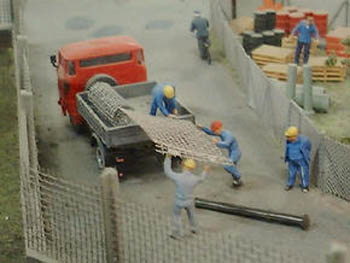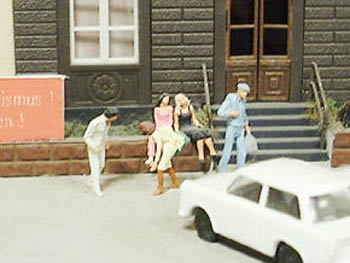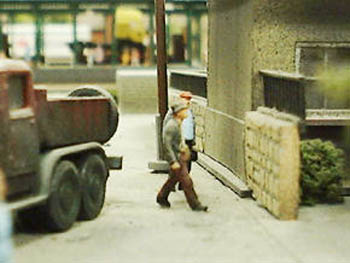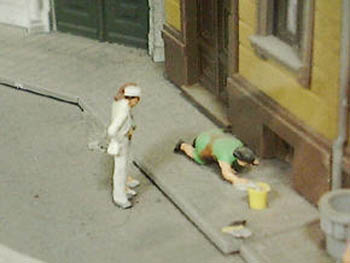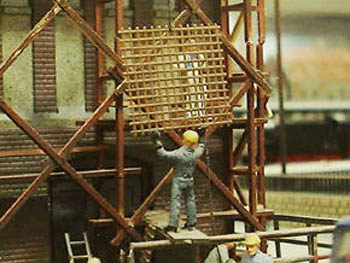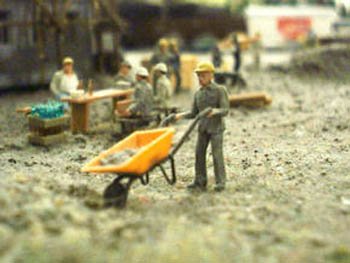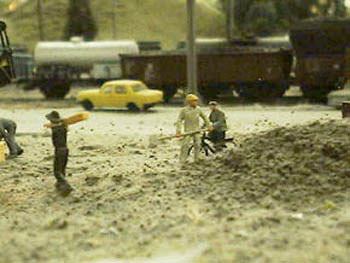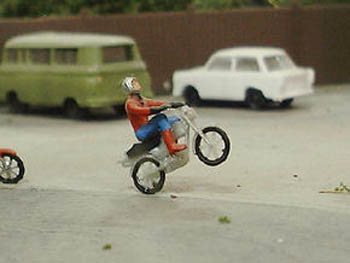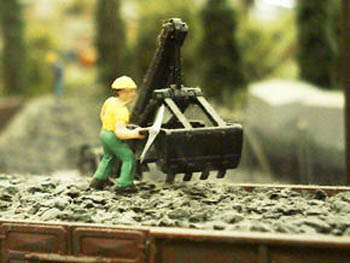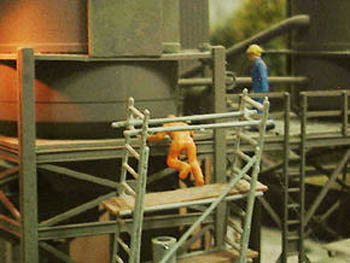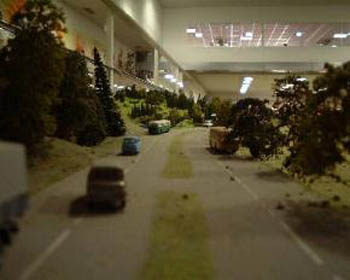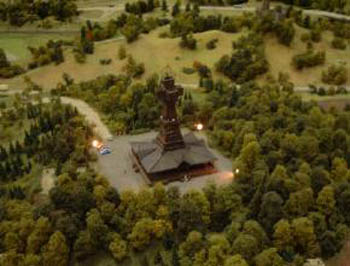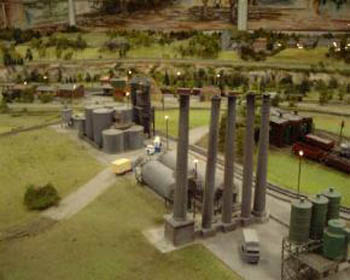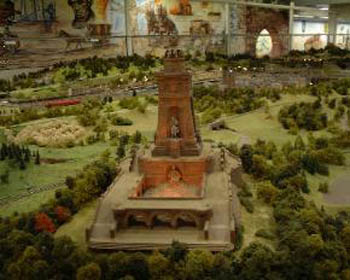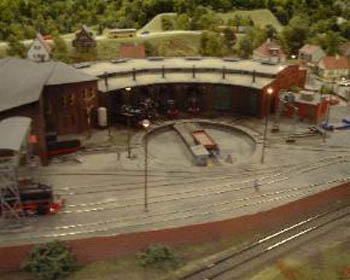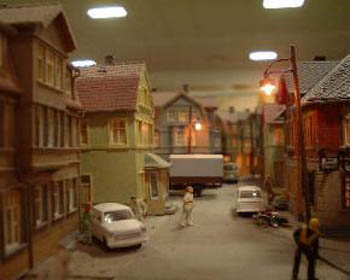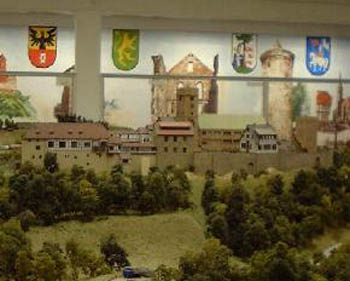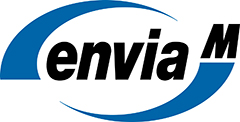Thuringia in the scale 1:87 since November 1997
The barn conversion emerging area had an exhibiton area of 500 quare meters for the installation of Thuringia. For this installation were scheduled 50 meters in length and 10 meters in width. The goal of managing director Hans-Jörg Stiegler was tu represent he region between the railway linse Eisenach - Erfurt - Weimar in the south and Leinefelde - Nordhausen - Blankenheim in the north.Wiehe lies roughly in the middle and has for day trips to Erfurt, the Kyffhäuser, Nordhausen and Weimar an ideal starting position. This should be the installation and thus indicates its tourist function requirements.

It was therefore present the following points.
The Wartburg in Eisenach as a significant monument of German history
The monument Kyffhäuser as strinking point in the northern Thuringia
Nordhausen as a railway junction on the Harz
Parts of the scenic valley Unsturt with the line Naumburg - Artern
The railway node of Eisenach, Leinefelde, Erfurt and Weimar
In addition, Meiningen as the location of the famous steam locomotive forgings, rail nodes Saalfeld and Skatstadt Altenburg are to see. The installation reflects the sixties and seventies back to show the steam-, diesel- and electric-locomotieves. An exception is the replica of the projected ICE Munich-Berlin in northern Thuringia. At the installation was 1950 meters track and 400 switsches relocated. The main geographical points are Erfurt, Weimar, Altenburg, Eisenach, Nordhausen, Leinefelde, Meiningen, Laucha, Roßleben and Karsdorf. The Wartburg and the Emperor's monument on the Kyffhäuser above as the highest surveys the landscape. The installation swallowd a total of 20.000 hardwood trees and 8.000 needle trees. The word of Thuringia as a "green heart of Germany" is also reflect in the model. With the help of several thousand model kits of the company's Kibri, Auhagen, Faller-Pola and Vollmer it was succeeded to put the cities in scene. The installation features two twin main lines, the ICE Magistrale and six branch lines. The southern part is dominated by the old main line of Eisenach - Erfurt - Weimar. On the north side, the main runway of Leinefelde about Nordhausen and Blankenheim. In the middle and eastern part of installation you can see the ICE route. In Eisenach branches from a side rail, according to the motives of the old railway ends in Werra-Meiningen. Saalfeld is located south of Weimar, a hub for two minor lines, which act as the main routes. One of them is connected with Altenburg. The longest branch line was inspired by the Unstrut train, the most interesting designs after the former "rail gun" in the section Leinefelde - Geismar.
120 trainsuite with as many locomotives and over 1000 wagons, two locomotives and three fast ICE trains are fully atomated in continuous use. The small models are in their daily duration of nine hours in very high mechanical and electrical loads. In each week per model are over sixty hours of operation together. These are certainly benefits to which we have seen in the manfacturing companies in Salzburg, Zwickau and Waiblingen with all law can be proud of.
Length: 46.5 m Wagons: 1.000
Width: 10.0 m Kits: 2.800
Total: 465.0 qm Hardwood trees: 20.000
Track length: 1.950 m Needle trees: 8.000
Tournout: 400 Cable length: 30.000 m
Trainsuite: 125
Tour through Thuringia
Climbing the Doppelstockzug DR at the station Geismar and ride with steam over the Legenfeld bridge, pass the Truppenübungsplatz Kindl, gone in the direction Leinefelde.
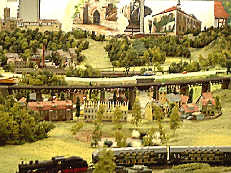
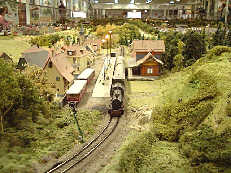
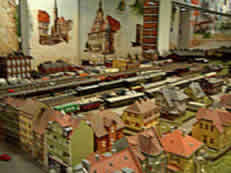
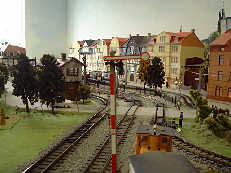
After we had exchanged a few sentences, we counted the switching frequency, calculated a day and were amazed: 700-850 circuits. That makes no mechanics. Thus, alterations in signaling.
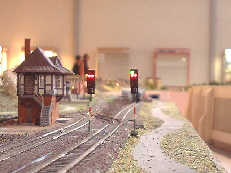

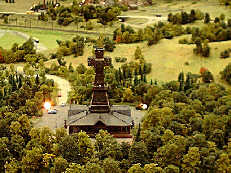

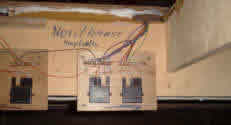
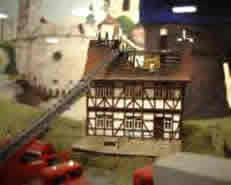
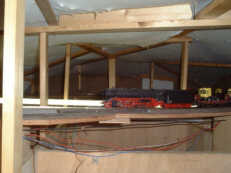
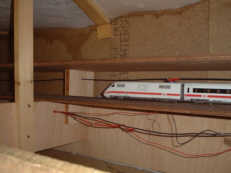
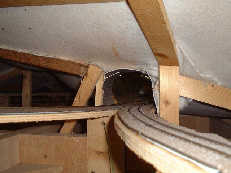
With the trolley ride or not?
Many visitors wonder why we do not take a trolley ride. It is simply not true.
Who should be the overhead wire and the switch Pandografen of locomotives, with a route length of ca. 180 m and with a mileage of approximately 3.5-4 km a day?
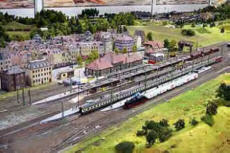


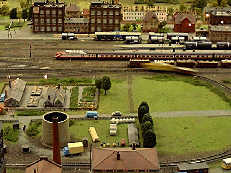
The Planning
For the Thuringia installation itself the Managing Director Hans-Jörg Stiegler had already very concrete ideas. With the rebuilding of the straw storage barn into a spacious, heated indoor exhibition space was created, an exhibistion area of approximately 500 square meters. On this base should be guided by the ideas of the client a large investment are in monlithic form. The rough edges dimensions were about 50 meters in length and 10 meters in width. Although Hans-Jörg Stiegler knews well the various construction of the model railway, he stayed with his idea of a super-rectangle installation so, as he himself says, those surprise effect, only the surface of a giant model of continuous landscape, especially as they are in offers a harmonious whole. Also with regard to the motive from the beginnig there were certain requirements to: for Mr. Stiegler it was not important to model the entire federal state Thuringia, but rather should be a restriction on the topic of Landscape and the railway in northern and central Thuringia.
Wiehe is located north of Weimar. For scheduled tourist ventures to well-known points of Thuringia and Saxony-Anhalt, such as Erfurt, to Kyffhäuser, to Nordhausen and to the Harz on the southern edge, but also to the sunny vineyards into Unstrut in Freyburg, the township has and ideal, central start position.
Track laying
The next Stepp was the track-laying. Elected the mushroom elite track of the Saxon Company Tillig with the best-made and quite close gravel bedding. In the construction phase 1.950 meter track and 400 switches was relocated. The railway works followed the wiring and a first trial run. When this was satisfactory, the construction began with troops of the terrain.
Visitors are alway surprised when they hear that we needed 20.000 hardwood trees and 8.000 needle trees, so well-known word from the "green heart of Germany" a credible reflection could find.

The Vehicles
What the small, delicate models in Wiehe must do, is suddenly clear when you consider that daily average mor than eight hours on the installation must purr. Per week, so were conservative estimates, for each model are nearly sixty hours of operation. The basic equipment of the installation was made with driving the vehicles of the company's Roco, Brawa and Gützold. Absolute record holder in the trouble-free operation was one of the most used high speed ICE train from Roco: In October 1998, almost a year after the opening, a ICE-train driving head with consistent completely worn wheel circles had to be take out from the service used. Technician Jürgen Liebe, leads exact protocol about the mileage on his proteges, identified for the ICE train with wheel circles damaged head around 4.2000 mileage real kilometers. A similar lasting power performed a model of the 219 series from Gützold. The duration burners, with only minor repair effort still persevere, include the models of series 01, 44 and 57 and E 04, E 18 and E 94 by Roco. By Gützold it is mainly the diesel locomotives of series V 60, V 180, 119 and 120, with their mileage far beyond the original expectations.
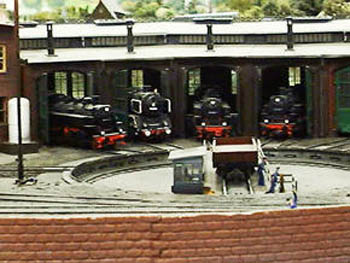
The Election Period
Of course, belonged to the motive the choice of the era was matter. The decision was made to the transitional period of the epoch III and epoch IV. For the builder it was particularly improtant to use all three types of traction, so steam, diesel and electric locomotives, because he want to set certain engineering and traffic history accent.
The Urban Design
Even if infinite space seems to have in Wiehe, it's far from that building and planning were generous by the hand. Of course, the most striking cities are built. What was the problem? For the realistic portrayal of Erfurt even 500 square meters wolud still have been too small. Therefore a compromise had to be. He was the city with ist houses, ist streets and points marked by an extremely dense development concentrated and indicate a large sprawl of land in any cas be avoided. No one has been pushed out that the city faces visibly smaller than the real territories of the great role originals.

The construction
After the subject and era were fixed, it went fairly quickly to create the necessary technical and craft. In order to lay the foundation of in Wiehe acting model railway club define the proven frame design notes. Since it was obviously impossible for such a huge piece on the frame construction to create the space in individual segments dissolved. 171 of these wooden frames formed, arranged in eight rows, the whole basis of the large constraction equipment, the resultunig dimensinos of exactly 45.6meters x 10 meters. On the frame were attached route boards plywood - under a track plan to create the main routes of North Thuringia. Wherever there is for more stations or landscapes, the builders relocated stable plates. Like in the home installation the best distance strips served as the replication of rise and slope lines, that are eqsy on the longitudinal and transvers beams of the basic design have been screwed. The "underfloor" relocated lines and shadow stations was procedures in reverse order.
The technique
The principle of the technique is quickly explained: Each track is a viewer for the very difficult recognizable, a giant oval, in a variety of individual block sections and on which up to 15 different trainsuite drive. Under the last wagon of each train is a permanent magnet, that has a switching contact in the track just passing the block section in the block for the following distance train unlock. This train controls in the same way his successors, until the circle closes and the last train animated the first train off or onward journey by the magnet and track contact. At the installation are a total of three twin main lines and six long secondary lines. Only the parade route of the installation, the ICE Munich-Berlin route, based on a computer control.



